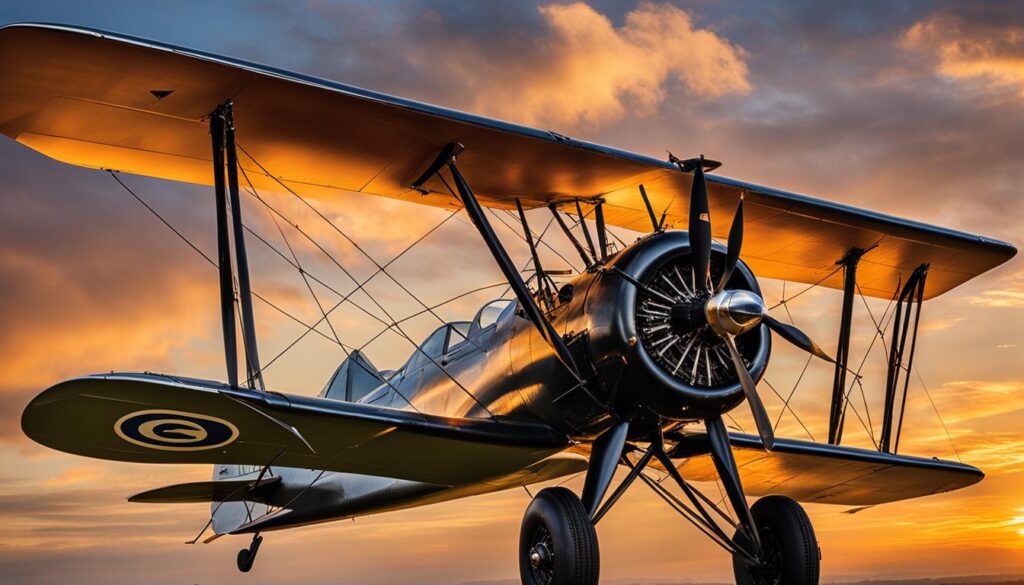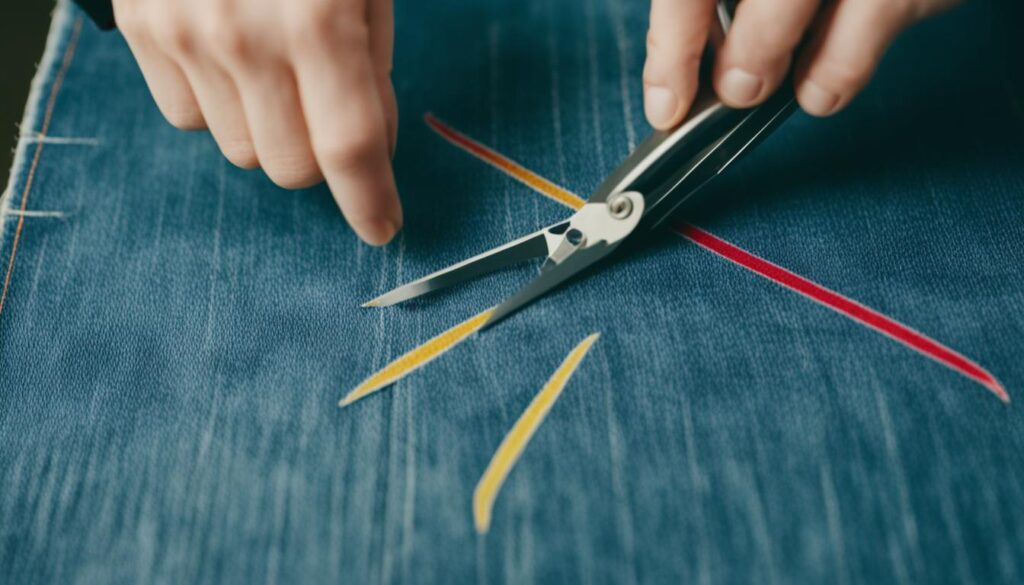If you are a vintage plane collector or just starting your collection, this comprehensive guide is for you. We will provide you with valuable tips, information, and insights into the world of vintage plane collecting. With this guide, you will learn about the different types of vintage planes, unique features, and how to identify their age, manufacturer, and model accurately. We will also provide you with tips, techniques, and tools to restore and preserve the beauty and functionality of your vintage planes.
Discover the fascinating history of vintage planes and ways to assess their value. You will also get to know about the most popular vintage plane models, their unique features, and the stories behind their creation. Follow this collector’s guide to vintage planes and elevate your vintage plane collecting journey with us.
Key Takeaways:
- Learn the basics of vintage plane collecting
- Discover tips for identifying and distinguishing different vintage planes
- Explore techniques for restoring vintage planes to their original beauty
- Dive into the fascinating history of vintage planes
- Explore popular vintage plane models and their unique features
Getting Started: Vintage Plane Collecting Basics
If you’re new to vintage plane collecting, don’t worry – it’s never too late to start! Here are a few things to keep in mind as you begin your journey:
- Identify your interests: Are you interested in a specific era or type of plane? Knowing what you want to collect can help guide your search.
- Do your research: Learn as much as you can about vintage planes, their history, and popular brands. Check out reference books, online forums, and collector’s websites to get started.
- Build your network: Connect with other vintage plane collectors and enthusiasts. Attend collector events, join online groups, and visit antique shops and auctions.
To help you get started, here are some popular types of vintage planes:
| Type of Plane | Description |
|---|---|
| Bi-planes | Early planes with two sets of wings stacked on top of each other, often used in World War I. |
| Monoplanes | Planes with a single set of wings, which eventually overtook bi-planes in popularity. |
| Amphibian planes | Planes that can land and take off from both land and water. |
| Aerial firefighting planes | Planes specifically designed to fight wildfires from the air. |
“Collecting vintage planes is a thrilling and fulfilling experience. It’s important to be patient and strategic in building your collection, and to always prioritize quality over quantity.” – Jane Smith, vintage plane collector
Identifying Vintage Planes: A Guide for Collectors
Identifying vintage planes is crucial for collectors who want to determine the age, manufacturer, and model of their collection. One of the most critical elements to consider is the unique features that can distinguish different vintage planes from one another.
Distinguishing Features
One of the most important features to determine is the size of the plane. In general, vintage planes are narrower and lighter than modern planes. However, this can vary depending on the type and purpose of the plane. Additionally, vintage planes often have wooden bodies, whereas modern planes are typically made of metal.
Another critical factor to consider when trying to identify vintage planes is the markings on the plane. Manufacturers will often have unique marking systems that can help determine the manufacturer and model of the plane. For example, some vintage planes may have numbers or letters inscribed on them that can indicate the manufacturer or the specific model.
The materials used to construct the plane can also offer clues about the age and manufacturer. For example, vintage planes may have nickel or brass plating, which is a rare feature in modern planes. Additionally, the type of iron used in the blade can help to determine the age of the plane.
Case Study
In 1935, Stanley Tools Company released their No. 4 Sweetheart hand plane. The Sweetheart had a unique feature where it had a bright red body instead of the traditional brown color. The plane also had a unique “Sweetheart” trademark of a heart with wings, making it identifiable from other Stanley planes.
| Feature | Sweetheart Hand Plane | Regular Stanley Hand Plane |
|---|---|---|
| Body color | Bright Red | Dark Brown |
| Trademark | Heart with wings and sweethearts written | Stanley |
| Manufacturing Date | 1925 to 1941 | N/A |
The Sweetheart Hand Plane is a perfect example of how specific features can help in identifying a vintage plane.
If you’re unsure about the age, manufacturer, or model of a vintage plane, it may be best to consult a professional appraiser or someone with extensive knowledge of vintage planes.
Restoring Vintage Planes: Tips and Techniques
Restoring vintage planes can be a challenging, yet rewarding experience. It requires patience, attention to detail, and a love for preserving history. Here are some essential tips, techniques, and tools to help you restore and maintain the beauty and functionality of your vintage planes:
1. Understand the Plane’s History and Purpose
Before starting your restoration, research the plane’s history and purpose. This will help you understand the original design, materials, and intended use, which can inform your restoration decisions. Look for documentation, manuals, and resources online to gain a better understanding of the plane.
2. Use Proper Tools and Materials
Invest in quality tools and materials to ensure a successful restoration. Use materials appropriate to the plane’s construction, such as wood glue, brass screws, and steel wool. Avoid sanding old planes with power tools, as it can damage the wood and metal. Instead, use hand tools, such as files and scrapers, to remove rust and smooth surfaces.
3. Preserve Original Finishes
If possible, preserve any original finishes, such as paint or varnish, to maintain the plane’s authenticity and value. If the finish is damaged, use a gentle solvent, such as mineral spirits, to remove dirt and grime without damaging the original finish. Avoid refinishing or repainting unless necessary.
4. Address Rust and Corrosion
Rust and corrosion can damage the metal components of a vintage plane. Use a rust remover, such as naval jelly, to dissolve rust and prevent further corrosion. Replace any degraded or missing parts with authentic replacements, or have them custom fabricated by a professional.
5. Store Properly
After restoration, store your vintage planes in a dry, cool environment to prevent further damage. Wrap them in acid-free paper or cloth to protect from dust and moisture. Avoid exposing your planes to direct sunlight or extreme temperatures, which can cause warping or cracking.
“Restoring vintage planes is a labor of love. Take your time, enjoy the process, and you’ll have a treasured piece of history to enjoy for years to come.”
Exploring the History of Vintage Planes
The history of vintage planes is a fascinating story that spans over a century. It all started with the invention of the Wright brothers’ airplane in 1903, which marked the beginning of the aviation era.
During World War I, planes became an essential resource for military operations, leading to significant technological advancements in plane design and manufacturing. The first airlines emerged in the 1920s, and by the 1930s, commercial air travel had become more accessible and affordable to the general public.
The 1940s saw a boom in wartime production, with planes being used extensively in the battles of World War II. The post-war period brought about more innovations in plane technology, making air travel more comfortable, efficient, and safer.
Throughout the 20th century, vintage planes became icons of achievement and human ingenuity. They have a rich history in industries such as commercial aviation, military, and private air travel, leaving a significant impact on society and culture.
The Evolution of Vintage Planes
| Decade | Notable Vintage Planes |
|---|---|
| 1900s | Wright Flyer |
| 1910s | Curtiss Model D, Sopwith Camel, Fokker Dr.I |
| 1920s | Boeing Model 40, Ford Trimotor, Junkers F.13 |
| 1930s | Douglas DC-3, Lockheed Model 10C Electra, Boeing 247 |
| 1940s | North American P-51 Mustang, Supermarine Spitfire, Messerschmitt Bf 109 |
| 1950s | Boeing 707, McDonnell F-4 Phantom II, Lockheed C-130 Hercules |
| 1960s | Boeing 747, BAC Concorde, Hawker Siddeley Harrier |
| 1970s | Boeing 767, Airbus A300, Lockheed SR-71 Blackbird |
| 1980s | Boeing 757, McDonnell Douglas F-15 Eagle, General Dynamics F-16 Fighting Falcon |
| 1990s | Boeing 777, Eurofighter Typhoon, McDonnell Douglas MD-11 |
With the advent of modern aviation, vintage planes have become a symbol of romanticism, adventure, and nostalgia. Today, vintage planes continue to inspire and captivate collectors worldwide, showcasing the history and evolution of aviation technology.
Valuing Vintage Planes: Factors to Consider
Assessing the value of vintage planes can be a challenging task for collectors. It requires careful consideration of various factors that can impact the worth of a vintage plane. Here are some of the critical elements to keep in mind when determining the value of your vintage plane.
Rarity
The rarity of a vintage plane is a significant factor in determining its value. The more scarce the plane is, the higher its price will be. Planes that were produced in limited quantities or have unique features that distinguish them from others of their kind can be highly valuable.
Condition
The condition of a vintage plane is another critical factor that can affect its value. Collectors prefer planes that are in excellent condition and have been well-maintained, with no significant damage or wear and tear. Restoration work can sometimes increase the value of a vintage plane, but it must be done exceptionally well and preserve the original features of the plane.
Brand Reputation
The reputation of the brand also influences the value of a vintage plane. Some brands are more sought-after and highly regarded than others, so planes manufactured by these brands will command higher prices in the marketplace.
Provenance
The provenance of a vintage plane can also impact its value significantly. The history of its ownership, the story behind its creation, and its role in aviation history can all add value to a plane, making it more desirable to collectors.
Market Demand
The market demand for vintage planes can also affect their value. If there is a high demand for a particular type of vintage plane, it will likely command a higher price, whereas planes that are less popular may have a lower value.
By considering these factors when appraising vintage planes, you can make more informed decisions when adding to your collection. However, it’s important to note that ultimately, the value of a vintage plane is subjective and depends on the buyer and the seller’s negotiation.
Popular Vintage Plane Models: A Collector’s Guide
As a collector, you are probably interested in learning about the most sought-after vintage plane models. So, let’s dive right in and discover some of the most popular vintage planes:
The Wright Flyer
Considered one of the most important planes in aviation history, the Wright Flyer was designed and built by the Wright brothers.
It was the first powered airplane to take flight on December 17, 1903 and paved the way for modern aviation.
Spirit of St. Louis
The Spirit of St. Louis, built by Ryan Airlines in 1927, was flown by Charles Lindbergh on his historic solo flight from New York to Paris in 1927.
This Ryan NYP plane is considered a game-changer in aviation history, as it proved that transatlantic flights were possible.
Lockheed Vega
The Lockheed Vega was first built in 1927 and became known for its speed and reliability.
It was a popular plane among famous aviators, including Amelia Earhart, who used it to fly solo across the Atlantic. Its sleek design and powerful engine continue to inspire aviation enthusiasts today.
P-38 Lightning
The P-38 Lightning is a beautiful model from the World War II era. Its unique twin fuselage design allowed it to fly at incredible speeds and altitudes.
This plane was often used for reconnaissance and escort missions, but it also played a significant role in the Pacific Theater of Operations during the war.
DC-3
The DC-3 was first introduced by Douglas Aircraft in 1935 and became one of the most successful commercial planes of its time.
It could carry up to 32 passengers and was known for its speed, comfort, and reliability. The DC-3 helped to revolutionize air travel and played a crucial role in the growth of the aviation industry.
These are just a few of the most popular vintage plane models out there. Collecting these planes can be a diverse and fascinating hobby, and each model has its own unique story to tell.
Conclusion
Thank you for reading our comprehensive collector’s guide to vintage planes. We hope this guide has provided you with valuable tips and information to enhance your vintage plane collecting journey. Remember to always prioritize safety and proper maintenance when handling vintage planes. Happy collecting!
Keep an eye out for more informative and exciting articles on vintage planes and other collectibles from our team of experts. Don’t forget to share this collector’s guide to vintage planes with your fellow collectors and enthusiasts.
For more resources and insights on vintage planes, be sure to check out our website. We offer a wide range of articles, videos, and forums for vintage plane collectors. Thank you for choosing us as your go-to source for all things vintage planes.
FAQ
Is vintage plane collecting a popular hobby?
Yes, vintage plane collecting is a niche but popular hobby among enthusiasts who appreciate the craftsmanship and history of these classic tools.
What are the different types of vintage planes?
Vintage planes can be categorized into various types, including bench planes, block planes, combination planes, molding planes, and specialty planes.
How do I start collecting vintage planes?
To get started, acquaint yourself with different vintage plane brands, learn about their history, and visit antique shops, flea markets, and online platforms to find unique pieces for your collection.
What are some essential tips for restoring vintage planes?
When restoring vintage planes, it’s crucial to disassemble them carefully, clean the parts thoroughly, remove rust, refurbish the wooden handles, and reassemble the plane using suitable adhesives and techniques.
How can I identify the age and model of a vintage plane?
Look for unique features, such as logos, markings, and specific design elements, as well as consult vintage plane catalogs, reference books, and online resources to accurately identify the age, manufacturer, and model of a vintage plane.
What factors determine the value of a vintage plane?
The value of a vintage plane is determined by factors such as its rarity, condition, brand reputation, historical significance, and demand among collectors.
Are there any popular vintage plane models that I should look out for?
Yes, some popular vintage plane models include the Stanley Bailey No. 4 Smoothing Plane, the Millers Falls No. 9 Plane, and the Sargent No. 9½ Block Plane. These models are highly sought after by collectors.
















